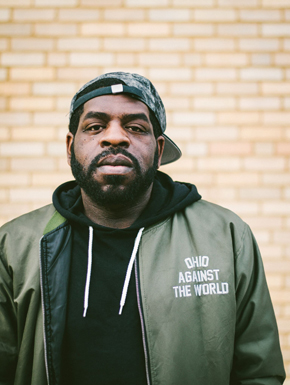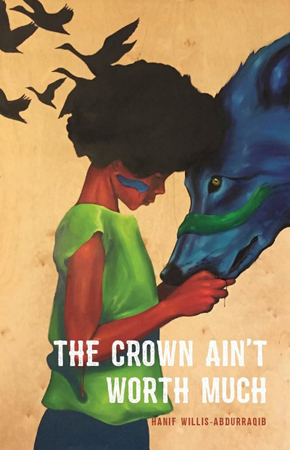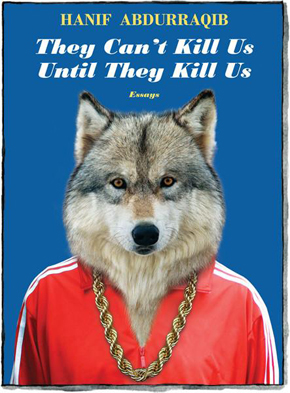One Clear and Clean
Surface on Which to Dance:
An Interview with Hanif Abdurraqib
by Karin Cecile Davidson
 Poet, essayist, and cultural critic, Hanif Abdurraqib has produced two celebrated volumes in recent years—“The Crown Ain’t Worth Much” (Button Poetry, 2016) and “They Can’t Kill Us Until They Kill Us” (Two Dollar Radio, 2017). Collections, respectively, of poetry and essays, both walk the territory of family, friendship, and community with compassion, depth, and clarity. There is no shying away from the disparity and death that crack open these worlds; instead, there is facing them, staring right through them to what truly is and what could be. Broken bodies, broken glass, mothers’ arms, closed caskets, hunger, jukeboxes, brothers, ghosts, bullets, grieving, missing those gone and those gone missing. And inside of all this is the thought: What would it be like to look up into the stars instead of fleeing “midnight and questions that come with it”?
Poet, essayist, and cultural critic, Hanif Abdurraqib has produced two celebrated volumes in recent years—“The Crown Ain’t Worth Much” (Button Poetry, 2016) and “They Can’t Kill Us Until They Kill Us” (Two Dollar Radio, 2017). Collections, respectively, of poetry and essays, both walk the territory of family, friendship, and community with compassion, depth, and clarity. There is no shying away from the disparity and death that crack open these worlds; instead, there is facing them, staring right through them to what truly is and what could be. Broken bodies, broken glass, mothers’ arms, closed caskets, hunger, jukeboxes, brothers, ghosts, bullets, grieving, missing those gone and those gone missing. And inside of all this is the thought: What would it be like to look up into the stars instead of fleeing “midnight and questions that come with it”?
“The Crown Ain’t Worth Much” and “They Can’t Kill Us Until They Kill Us,” collections distilled through the lens of music, channel Abdurraqib’s thoughts about what it is like to grow up a black boy on the eastside of Columbus, Ohio and become a black man of the world, surviving in a country where the black body is under constant attack. The poems and essays are philosophical, insightful, aware, intensely emotional and reverent and angry and impassioned, and more. Chance the Rapper, Bruce Springsteen, Prince, Carly Rae Jepsen, Fall Out Boy, Fleetwood Mac, Marvin Gaye, and dozens of other musicians fall across the pages, the meaning of the music tangled in hope, promise, politics, higher purpose, love, letting go, and heartbreak. Immersed in lyrics and rhythm and sway until the final act, when the music lingers in memory, and the fear, and the anger that grows from this fear—of being black, Muslim, undocumented, queer, transgender, feared for no reason other than looking, dressing, praying, speaking differently—become louder than the music. And the writing doesn’t take a break from opening up and examining the sins committed upon black bodies. The writing holds and hastens, breathes and sings; it is relentless and calls in the direction of those lost and those accountable; it grieves and cries out; it announces the sun and the moon; and it waits, wishing for celebration to take the place of destruction.
This, more than anything, is about how there is sometimes only one single clear and clean surface on which to dance, and sometimes it only fits you and no one else. This is about hope, sure, but not in the way that it is often packaged as an antithesis to that which is burning.
—Hanif Abdurraqib, “Chance the Rapper’s Golden Year”
KARIN CECILE DAVIDSON: In the essay, “Tell ’Em All to Come and Get Me,” rap star Kendrick Lamar’s “Alright,” the joy of the black greeting, and the death of Columbus poet and activist MarShawn McCarrel circle the subjects of pushing back against pain, of survival, and of hope and permission to revel in the act of living.
Hanif, would you speak about the complexities presented here, especially in terms of their relationship to the broader scope of the collection, for example, to Marvin Gaye and fireworks and “darkness turned inside out”?
HANIF ABDURRAQIB: I’m often thinking about the mundane act of living—rather, what it is to be alive in a life that none of us particularly asked to be born into, and trying to make the best of it regardless. And so, I hit a point where I wanted to think about the many things that have kept me alive, and so I’ve been thinking about living as a choice. And, as with any choice, it becomes sometimes difficult. I spent a lot of time thinking about MarShawn, who I knew and cared for, and watched grow and struggle. And when he killed himself, his legacy or his full self was really flattened into this monolithic idea of what it was to be black / male / activist / no longer alive. And I struggled with that, because I knew how easily that could also happen to me, or anyone else I loved. And so, I began to relentlessly chase this idea of unraveling the greater person. Giving a person a whole life and history or mythology to a person when they’re no longer here to build their own is something I want for myself. And so, I aimed to do that for MarShawn, for Marvin Gaye, for any who are complex and more than just a single thing.
And so, this is about the choir and about those who might be bold enough to join it before another wretched year arrives to erase another handful of us. This is, more than anything, about those interested in singing.
—Hanif Abdurraqib, “Chance the Rapper’s Golden Year”
DAVIDSON: The architectures of “The Crown Ain’t Worth Much” and “They Can’t Kill Us Until They Kill Us” call up Roman numerals and Marvin Gaye, punctuated with “On Kindness,” “On Hunger,” “On Jukeboxes” and Melting and Sainthood and “On Future and Working Through What Works.” Structures occur within structures, introducing odes and erasures, black barbershop dispatches, couplets, repetitions, and rhythms.
How did you decide on the structural sequences, divisions, and patterns in each collection?
ABDURRAQIB: Well “Crown” is strictly linear. It’s telling a story that is tasked with having some echoing themes and motifs, which made the sequences easier to put together. The book is supposed to be building a geography and then allowing a reader to watch the geography change, as the character within the poems also changes and also becomes more aware of the world around him. With “They Can’t Kill Us,” I wanted to raise the stakes around what it is to earn joy. And so, I opened with more hopeful work and closed with hopeful work, but in the middle, I aimed to complicate the ideas of hope and joy. Two things which, when standing on their own, don’t offer much to a reader. But the truth is, those two emotions are hard to arrive at and hard to hold on to. And I didn’t want to gloss over that.
the ones on sheridan ave stopped playing Motown in the fall once
the frat boys found out they could drink for cheap & stumble
down the block loud & pulsating with the night the way our fathers
used to when this side of town was still thick with their fingerprints—Hanif Abdurraqib, “On Jukeboxes”
 DAVIDSON: Tell us about place in your writing. How the Columbus eastside basketball courts & convenience store corners & clubs & doorways & porches & playgrounds, along with neighborhoods & streets & states of being—like Linden & Little Brothers & loneliness, Livingston & the Newport & hushed prayers—have entered and influenced your words and worlds.
DAVIDSON: Tell us about place in your writing. How the Columbus eastside basketball courts & convenience store corners & clubs & doorways & porches & playgrounds, along with neighborhoods & streets & states of being—like Linden & Little Brothers & loneliness, Livingston & the Newport & hushed prayers—have entered and influenced your words and worlds.
ABDURRAQIB: Yeah, I mean I was drawn to writing about place because I grew up in a moment when place was really vital, but not any place that was familiar to me. In the early and mid ’90s, there were a lot of coastal narratives about black youth and growing up, and so I got to see the interiors of young black people alive in Compton, or Los Angeles, or New York, or New Jersey. I wanted to build something like that for my specific corner of the Midwest. And I knew that in order to do it, I had to find a way to make details stand out—to build a city that could be any city for someone who hasn’t been to it. And so, I begin with a general space, like a porch or a barbershop. And then I populate it with the specifics of my experience. I want people to see the familiar first, so they can get comfortable with the specificity of the community I’m inviting them to be a part of.
in the mirror, I would try to smile as wide as
my mother who, in the early ’90s, would sing pop music while
steam hung over her afro in the kitchen & who would crane her
neck backwards to laugh like the jokes were spilling from god’s
own pockets—Hanif Abdurraqib, “There Is the Picture of Michael Jackson Kissing Whitney Houston on the Cheek”
DAVIDSON: The essay, “In the Summer of 1997, Everyone Took to the Streets in Shiny Suits,” describes the narrator’s loss, at the age of thirteen, of his mother, her untimely death in the late spring, a few months after that of Notorious B.I.G. Summer stretches out to the soundtrack of “Mo’ Money, Mo’ Problems,” and the Diana Ross-sampled hit calls back the lost mother. Add in the way life and death exist together in the funeral processions and the culture of New Orleans, as well as the narrator’s wish to see his mother again, to hear her laugh and tell her stories of that summer of ’97. Hanif, if you had anything more to add to this beautiful piece, what would it be?
ABDURRAQIB: I think, simply, I would add a thank you to grief in all of its forms, for the soundtrack it has allowed me to make of its haunting.
 DAVIDSON: Speak a bit about “On Paris,” on being black, on being Muslim, on wishing for safe spaces and survival in this world, on the places that prayer & concert venues & places where those seeking freedom and belonging and togetherness are bombed and covered in blood.
DAVIDSON: Speak a bit about “On Paris,” on being black, on being Muslim, on wishing for safe spaces and survival in this world, on the places that prayer & concert venues & places where those seeking freedom and belonging and togetherness are bombed and covered in blood.
ABDURRAQIB: I am consistently anxious about the concert space becoming more treacherous for those who attend shows. I wrote that piece because I was thinking about concerts as a place where I felt like less of an outsider, even when the concert had elements which pushed me to its margins. And so, there’s a real challenge in articulating fear around the sacred space becoming dangerous, or coming to terms with the fact that the world we’re in now means nothing is safe, or nothing is sacred. I’m trying to get to the root of that, and what it means for the comforts I once took for granted.
Nina Simone knew well that black people have a different relationship with boats, with chains, with the South, with freedom and the haunting that comes with not having it. “Pirate Jenny” was my introduction to Nina Simone, and it has informed how I have chased after her work ever since.
—Hanif Abdurraqib, “Nina Simone Was Very Black”
DAVIDSON: When a friend of mine drove back into New Orleans after Katrina & the levee breaches & the flooding & the destruction of property & lives, Nina Simone came on the radio. With the first lines of “Feeling Good”—“Birds flying high, you know how I feel”—he noticed the sorrowful irony of the song at that moment in that incredible voice. For there were no birds. Anywhere.
Tell us something else about Nina Simone.
ABDURRAQIB: Nina Simone wasn’t her real name! I found this out way late, maybe like five years ago. It was a name she adopted in her early 20s to stop her mother from knowing about her performances.
Our fights aren’t going to be equal in the world, but if we are pushing our backs against the same barriers of injustice, I would like my anger to live in the world as your anger does. Reasonably, with expectations that it doesn’t make me who I am. It is a task, some days. To think about your consistent kindness as, instead, a product of restraint.
—Hanif Abdurraqib, “On Kindness”
DAVIDSON: “On Kindness” is an important, strong, beautiful statement on how one is allowed or forbidden emotions when those feelings have been building since birth. More than ever and same as ever, injustices continue to mount, too many to be tallied. Channeling emotions into poetry, into song, into ferocious dance calls for audiences to come forward and participate, while others stay away in fear. There is disconnection and there is creating connection.
Hanif, you’ve done an elegant and amazing job of bringing together artists in Columbus for conversation and in creating a more engaged literary community in the city. What do you have in mind for the future, in terms of poetry, of speaking out, of bringing people together and supporting the arts, and of other concerns and projects?
ABDURRAQIB: I’ve started a new quarterly reading series in Columbus featuring poets of color from all over the country who are on their first book. It’ll be at the OSU Urban Arts Space starting in October with Nabila Lovelace. I really wanted to bring a nationwide reading series to the city. Much like bands on tour, poets with books sometimes skip over the city due to lack of opportunity, and I was eager to open up new opportunities for folks, as well as introducing an emerging poet to the city who might have strong things to say about their work and about making a book, and about all of the things that go into that. My main goals are to shift the resources I have back into the city, to keep furthering the artistic ambitions of the immensely gifted people who I’m lucky to share a town with.

Karin Cecile Davidson, Interviews Editor
